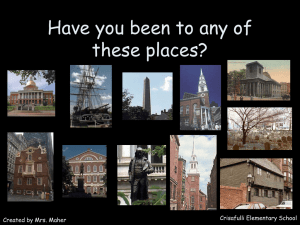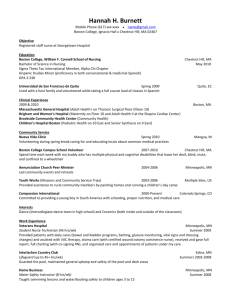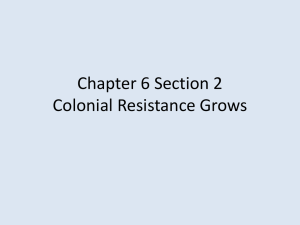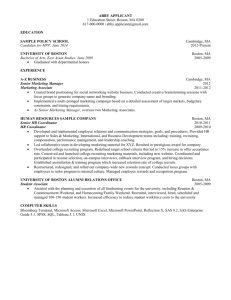Boston Common The starting point of the Freedom Trail, Boston
advertisement
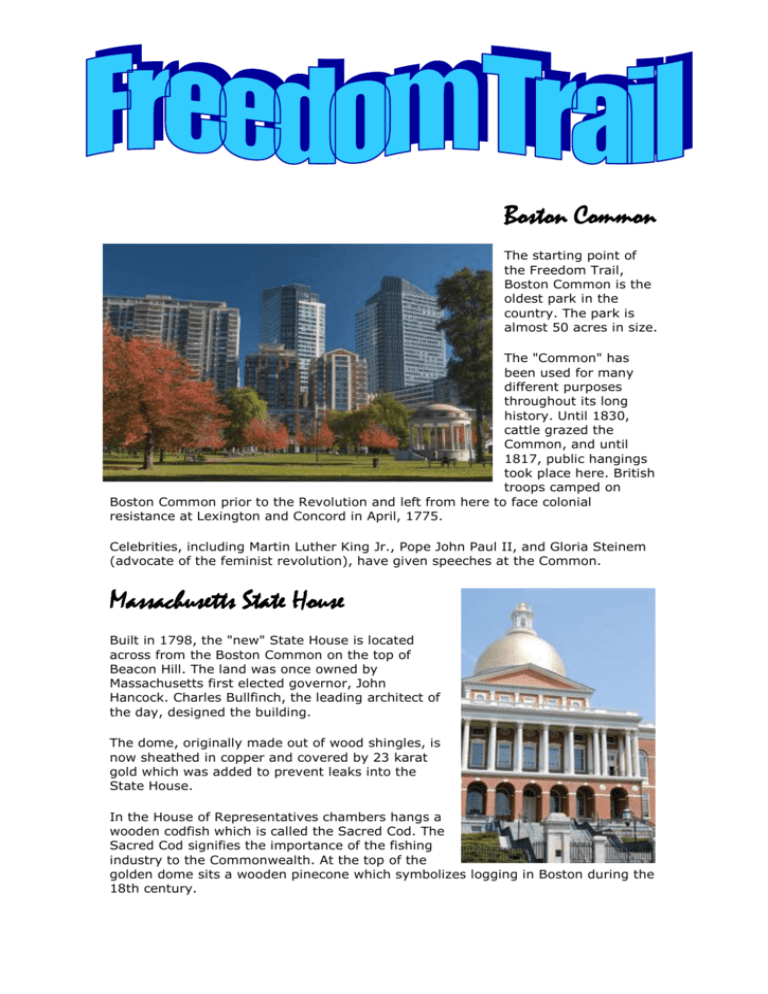
Boston Common The starting point of the Freedom Trail, Boston Common is the oldest park in the country. The park is almost 50 acres in size. The "Common" has been used for many different purposes throughout its long history. Until 1830, cattle grazed the Common, and until 1817, public hangings took place here. British troops camped on Boston Common prior to the Revolution and left from here to face colonial resistance at Lexington and Concord in April, 1775. Celebrities, including Martin Luther King Jr., Pope John Paul II, and Gloria Steinem (advocate of the feminist revolution), have given speeches at the Common. Massachusetts State House Built in 1798, the "new" State House is located across from the Boston Common on the top of Beacon Hill. The land was once owned by Massachusetts first elected governor, John Hancock. Charles Bullfinch, the leading architect of the day, designed the building. The dome, originally made out of wood shingles, is now sheathed in copper and covered by 23 karat gold which was added to prevent leaks into the State House. In the House of Representatives chambers hangs a wooden codfish which is called the Sacred Cod. The Sacred Cod signifies the importance of the fishing industry to the Commonwealth. At the top of the golden dome sits a wooden pinecone which symbolizes logging in Boston during the 18th century. Park Street Church Park Street Church, the site of the old town granary where grain was kept before the Revolution, dates back to 1809. Its 217 foot steeple was the first landmark travelers saw when coming into Boston. Park Street Church is located at Brimstone Corner which may have received its name because preachers spoke of fire and brimstone in Hell to their congregation or because sulfur was stored in the basement of the church. This Evangelical Church of "firsts" is the location of the first Sunday school in 1818 and the first prison aid in 1824. On July 4, 1829, William Lloyd Garrison gave his first public anti-slavery speech here. Granary Burying Ground Founded in 1660, the Granary is the third oldest burying ground in Boston proper. In 1737, when grain was stored where the present Park Street Church stands, the burying ground was renamed the Granary. Along with Massachusetts Governors, Clergymen, and Mayors, three signers of the Declaration of Independence, Samuel Adams, John Hancock, and Robert Treat Paine, are buried here. Approximately 5000 people are buried at Granary even though there are only 2300 headstones. Since funerals were expensive, there would be one headstone per family. Each grave contains at least 20 bodies. King´s Chapel and Burying Ground King's Chapel, designed by Peter Harrison, was constructed on land taken from the burying ground. To insure the presence of the Church of England in America, King James II ordered an Anglican parish to be built in Boston. Since none of the colonists were interested in selling suitable land for the Church, the King ordered Governor Andros to seize a corner of the burying ground for the Church of England. King's Chapel Burying Ground is the oldest burying place in Boston proper. The burying ground is the final resting place for many colonists, including John Winthrop, the Colony's 12 term governor; Hezekiah Usher, the colony's first printer; Mary Chilton, the first woman to step off the Mayflower. First Public School Site and Ben Franklin Statue The first public school in America was established by Puritan settlers in 1635 in the home of Schoolmaster Philemon Pormont and was later moved to School Street. Boys from various socio-economic backgrounds attended Boston Latin School until 1972 when girls were also accepted. A portrait statue of Benjamin Franklin overlooks the former site of Boston Latin School which Franklin, Samuel Adams, and John Hancock once attended. Franklin's place of birth was just one block away on Milk Street, across from the Old South Meeting House. located in Boston's Fenway neighborhood. The Boston Latin School is now Former Site of the Old Corner Bookstore Many famous books were published here, including The Scarlet Letter, Walden, and the Atlantic Monthly magazine. The Bookstore was built in 1712 as an apothecary shop, office and home of Thomas Crease. The outspoken Anne Hutchinson, who was exiled from the Bay State, owned the store before it was given to Timothy Harrington who turned it into a bookstore. The Old Corner Bookstore is one of Boston's oldest surviving structures. Today, the building is occupied by a jewelry store. Old South Meeting House Visit Boston's famed, National Historic Landmark where liberty found its allies and the American Revolution gained its voice. Within the walls of Old South Meeting House, meeting by meeting, vote by vote, a revolution began. Since 1729, when it was built as a Puritan meeting house, Old South Meeting House has played an important role in American history. It was on this site that the Judge Samuel Sewall publically apologized for his role in the Salem Witch Trials. It was on this site that Benjamin Franklin was baptized. In the years leading to the American Revolution, thousands of colonists gathered at Old South Meeting House to challenge British rule, most famously to protest the Boston Massacre and the tea tax. The largest building in colonial Boston, Old South Meeting House was the stage for an overflow meeting on December 16, 1773, which adjourned to Griffin’s Wharf for the infamous event that would become known as the Boston Tea Party. Almost a century later, Old South Meeting House was threatened with destruction. In 1876, Bostonians fought to save the building from the wrecker’s ball in the first successful historic preservation effort in New England. Old State House Also known as Boston's "Town House", the Old State House dates back to 1713. This Georgian style structure was occupied by the British during the Revolution and was a continuous reminder to the settlers of British dominance and presence in the colony. The Old State House was the center of all political life and debate in colonial Boston. On July 18, 1776, citizens gathered in the street to hear the Declaration of Independence read from the building's balcony, the first public reading in Massachusetts. The Royal Governor presided here until the new State House was built on Beacon Hill in 1798. Today, the building is run by The Bostonian Society as a Boston history museum. Boston Massacre Site In front of the Old State House, a circle of cobblestones commemorates the Boston Massacre. At this site, tensions between the colonists and British soldiers erupted into violence on March 5, 1770. A minor dispute between a wigmaker's young apprentice and a British sentry turned into a riot. The relief soldiers that came to the aid of the British were met by an angry crowd of colonists who hurled snowballs, rocks, clubs, and insults. The soldiers fired into the crowd and killed five colonists. Samuel Adams and other patriots called the event a "massacre". Faneuil Hall Faneuil Hall has served as a marketplace and a meeting hall since 1742. Funding was provided by a wealthy merchant, Peter Faneuil, for the construction and local artisan to create the grasshopper weather vane that still perches on the building's cupola. Inspirational speeches by Samuel Adams and other patriots were given at Faneuil Hall. These oratories became the footstool for America's desire to obtain independence from the British. Faneuil Hall was expanded in 1806 by Charles Bulfinch. When Boston became a city the use of Faneuil Hall as a government meeting place came to an end, but it was still regularly used. Today, the first floor is still used as a lively marketplace and the second floor is a meeting hall where many Boston City debates are held. Paul Revere House Built around 1680, this house is the oldest building in downtown Boston. It served as the home of silversmith Paul Revere and his family from 1770 to 1800. Paul Revere is famous for his "midnight ride" to Lexington, Massachusetts informing Samuel Adams and John Hancock that the British were coming to arrest them. In the 19th century, hundreds of Irish, Italian, and Jewish immigrants to the North End lived in the Paul Revere House and in the 20th century, the house was restored and converted to a museum. The site is owned and operated by The Paul Revere Memorial Association. Old North Church Known as "Christ Church in the City of Boston", this Episcopal church was built in 1723 and is Boston's oldest Church building. On the steeple of this church, Robert Newman signaled with lanterns the approach of the British regulars; "One if by land, and two, if by sea". The steeple is 191 feet tall, making it the tallest steeple in Boston. The bells within the steeple were the first bells ever brought to America. Paul Revere was one of the neighborhood bell ringers. The interior high box pews and brass chandeliers, as well as the Church's first clock are all original. Copps´s Hill Burying Ground Copp's Hill Burying Ground is Boston's second oldest burying ground. It was first founded in 1659 as Windmill Hill. The area was named after shoemaker William Copp who once owned the land. Thousands of artisans, craftspeople, and merchants are buried on the Hill. Additionally, thousands of African Americans who lived in the "New Guinea" community at the base of Copp's Hill are buried in unmarked graves on the Snowhill Street side. Also buried at Copp's Hill are Robert Newman, best known for placing the signal lanterns in the steeple of the "Old North" Church on the eve of the Battle of Lexington and Concord; Shem Drowne, the weathervane maker who crafted the grasshopper atop Faneuil Hall; and Prince Hall, the anti-slavery activist and founder of the Black Masonic Order. USS Constitution and Charlestown Navy Yard USS Constitution is the oldest commissioned warship afloat in the world. It was first launched in 1797. Constitution is one of six ships ordered for construction by George Washington to protect America's growing maritime interests. The ships greatest glory came during the war of 1812 when she defeated four British frigates which earned her the nickname "Old Ironsides," because cannon balls glanced off her thick hull. The ship was restored in 1927 with contributions from the nation's school children. The Charlestown Navy Yard was built on what was once Mouton's or Morton's Point, the landing place of the British army prior to the Battle of Bunker Hill. It was one of the first shipyards built in the United States. During its 174 year history, hundreds of ships were built, repaired and modernized, including the World War II destroyer USS Cassin Young. Today, thirty acres of the Navy Yard are preserved by the National Park Service as part of Boston National Historical Park. Bunker Hill Monument The Bunker Hill Monument stands 221 feet tall at Breed's Hill, the site of the first major battle of the American Revolution fought on June 17, 1775. Control of this high ground near the harbor was important to the British occupation of Boston. When colonial forces chose to fortify Charlestown, they bypassed the more dominant "Bunker Hill" and dug in on Breed's Hill which was lower and closer to the water. "Don't fire until you see the whites of their eyes" is the legendary order attributed to Colonel William Prescott to make sure that each shot would count. The poorly trained and ill prepared colonial forces repelled two major assaults by the British Army before retreating. Almost half of the British soldiers were either killed or injured. Although the colonists lost the battle, their bravery and strong showing against the British encouraged them to fight on. Visit the Bunker Hill Monument and climb the 294 steps that lead to the pinnacle. There are no elevators in the monument; however, the amazing vista at the end of the journey is well worth it.

